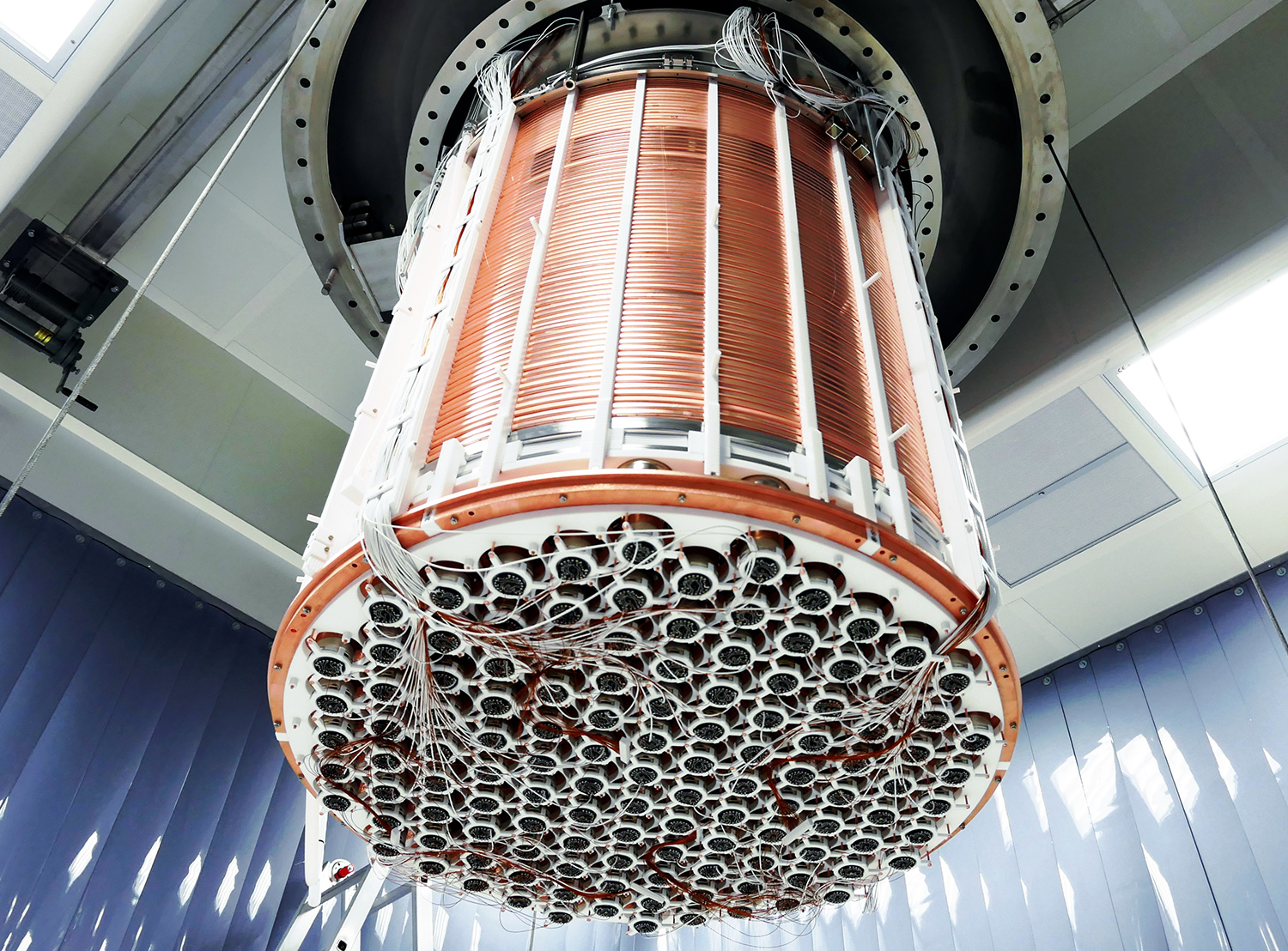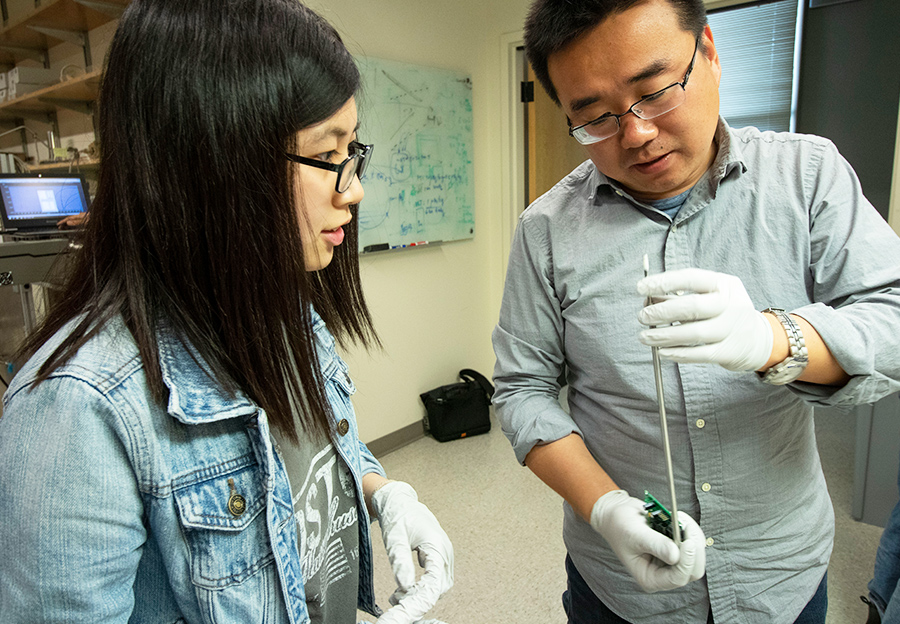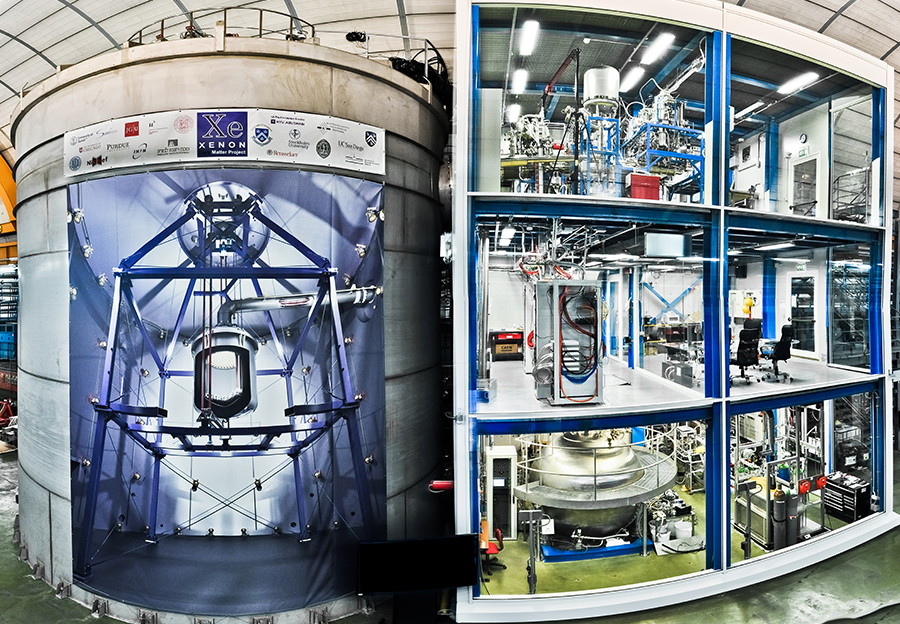Scientists Observe Rare Decay Process in the Universe
Nuclear decay a trillion times older than the Milky Way is measured directly for the first time
Published Date
By:
- Cynthia Dillon
Share This:
Article Content

The XENON1T detector installed underground at the Italian LNGS. Image courtesy of the XENON1T collaboration
It’s difficult to grasp the immensity of the age of the universe. Those 14 billion years, however, amount to only a moment compared to some physical processes. For example, there’s radioactive nuclei, Xenon-124 atoms to be precise, that decay on much longer time scales—about one trillion times longer than the age of the universe. Now, an international team of scientists, including researchers from the University of California San Diego, report in the science journal Nature that they observed the decay of these age-old atoms for the first time.
Using the XENON1T detector—a device used mostly to search for dark matter—the scientists tracked Xenon-124’s “half-life,” the time after which half of the radioactive atoms present in a sample have decayed. This observed radioactive decay is the rarest process ever observed in a detector and the slowest ever directly measured. The scientists’ new result offers information for further investigations on neutrinos—the lightest of all elementary particles whose nature is still not fully understood.
“The results demonstrate the powerful capability of the liquid xenon detector to search for extremely rare processes in nature that will provide insight into new fundamental physics laws,” says UC San Diego Associate Professor of Physics Kaixuan Ni, who is part of the XENON1T joint experimental project, made up of about 160 scientists from the U.S., Europe and the Middle East. Ni’s group contributed to the study.
A sensitive dark matter detector
Currently, scientists are searching for dark matter particles about 1,500 meters—4,921 feet—below the Gran Sasso Mountains in the Italian INFN laboratory LNGS. There the detectors are well protected from cosmic rays and radioactivity to avoid false signals. Theories predict that dark matter should rarely “collide” with the atoms of the detector. This assumption is basic to the operation of the XENON1T detector. When a dark matter particle interacts with a xenon atom, it transfers energy to the atomic nucleus which excites other xenon atoms. This leads to the emission of faint signals of ultraviolet light, which are detected by light sensors located around a cylinder containing two metric tons of ultra-pure liquid xenon target.

Postdoctoral Scholar Yuehuan Wei works with a student in the Ni Group to install a level meter in the liquid xenon detector development lab in Mayer Hall at UC San Diego. Photo by Michelle Fredricks, UC San Diego Physical Sciences
The new study shows that the XENON1T detector can also measure other rare physical phenomena, such as double electron capture. This occurs when two protons in the nucleus simultaneously “catch” two electrons from the innermost atomic shell, transform into two neutrons and emit two neutrinos. The other atomic electrons reorganize themselves to fill in the two holes in the innermost shell, releasing energy that is carried away by X-rays and the so-called Auger electrons. Double electron capture, incidentally, is the inverse process of double beta decay, first proposed in 1935 by the late UC San Diego Professor of Physics and Nobel Laureate Maria Goeppert Mayer.
The measurement
The XENON collaboration accomplished the novel measurement as X-rays from the double electron capture in the liquid xenon produced an initial light signal and delayed charge signal. The energy released in the decay was derived from the strength of the two signals. All signals from the detector were recorded over a period of more than one year, in blind fashion, meaning the scientists could not access the data until the analysis was finalized to avoid skewing the data with personal expectations. When the analysis was complete, the scientists concluded that 126 observed events in the data were indeed caused by the double electron capture of Xenon-124.
“We need to continuously monitor the detector performance using calibration sources and make proper signal correction in order to achieve the excellent energy resolution that is critical to this study,” explained Jingqiang Ye, a UC San Diego graduate student who performed data analysis for this study.
Status and outlook
The scientists currently are upgrading the experiment for the new “XENONnT” phase, which will feature an active target mass three times larger. Together with a reduced background level, this will boost the detector’s sensitivity by an order of magnitude.

The XENON experiment located underground in the Italian LNGS laboratory. The detector is installed inside a large water shield; the building next to it accommodates its various auxiliary subsystems. Image courtesy of XENON1T collaboration
Yuehuan Wei, a postdoctoral scholar at UC San Diego who leads the signal reconstruction group in the XENON data analysis, said, “XENONnT will not only allow us to search for rare interactions from dark matter, but also to study rare processes in neutrino physics with unprecedented sensitivity.”
The Ni Group at UC San Diego is supported by the National Science Foundation and the Abeloe Graduate Fellowship, a fellowship donated by Ken Abeloe (BS, physics, ‘91). The XENON experiment was supported by the National Science Foundation, the Swiss National Science Foundation, the German Ministry for Education and Research (BMBF), the Max Planck Gesellschaft, the German Research Foundation (DFG), the Netherlands Organisation for Scientific Research, the NLeSC, the Weizmann Institute of Science, I-CORE, Pazy-Vatat, Initial Training Network Invisibles, Fundacao para a Ciencia e a Tecnologia, Region des Pays de la Loire, Knut and Alice Wallenberg Foundation, Kavli Foundation, Abeloe Graduate Fellowship and Istituto Nazionale di Fisica Nucleare.Share This:
You May Also Like
Stay in the Know
Keep up with all the latest from UC San Diego. Subscribe to the newsletter today.



